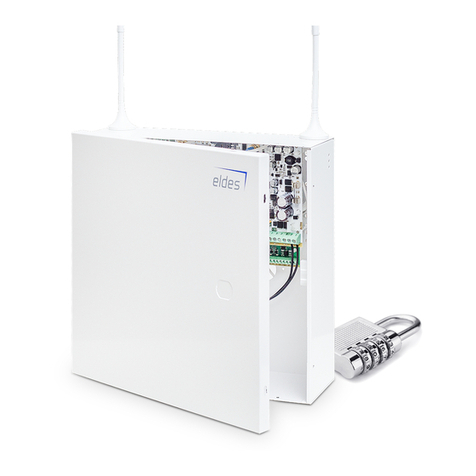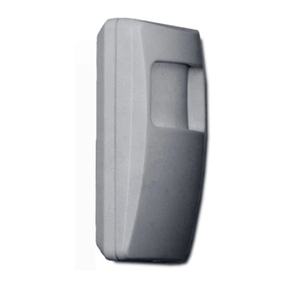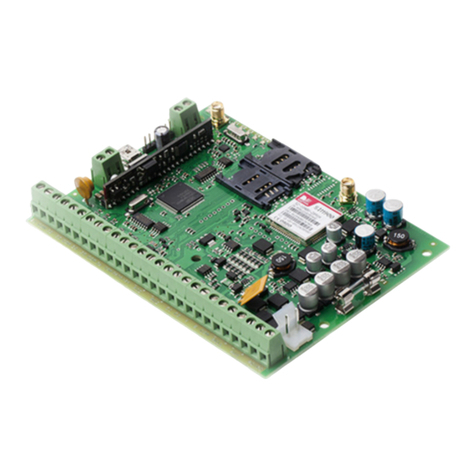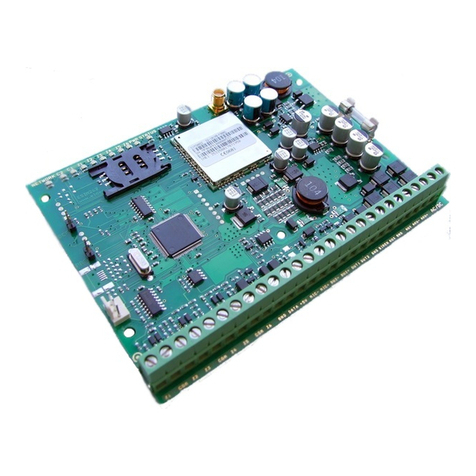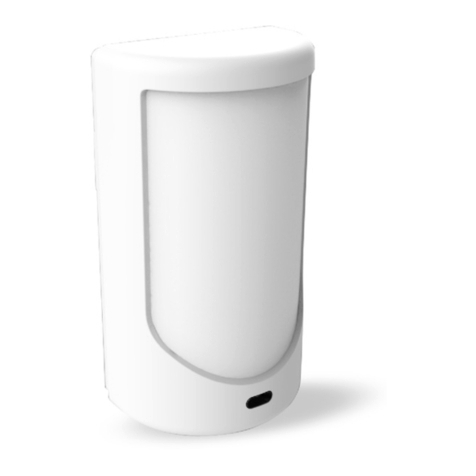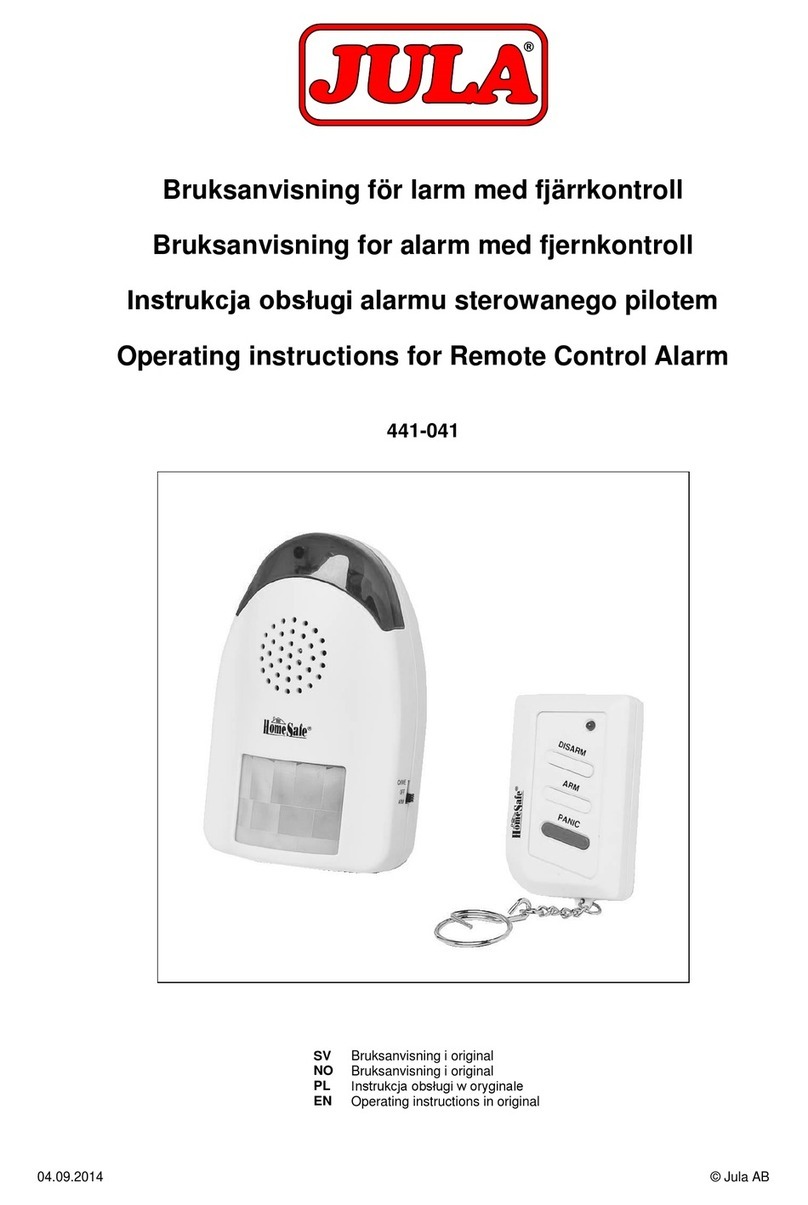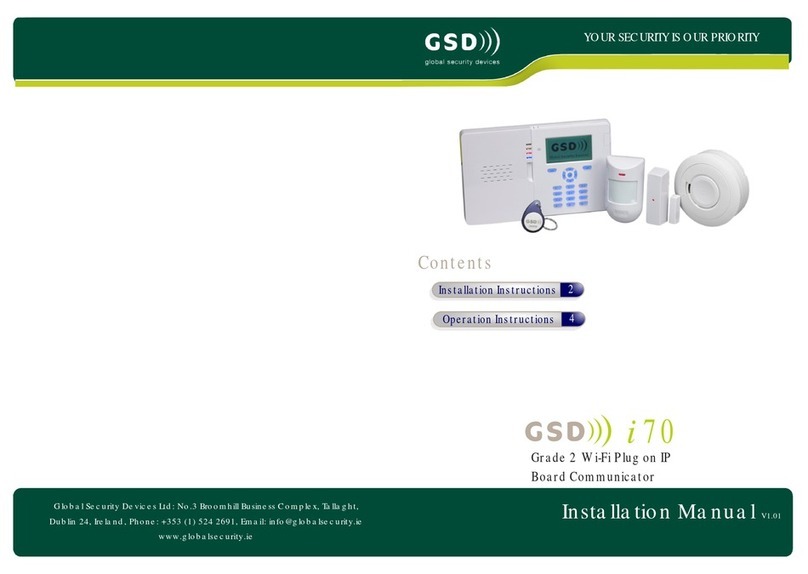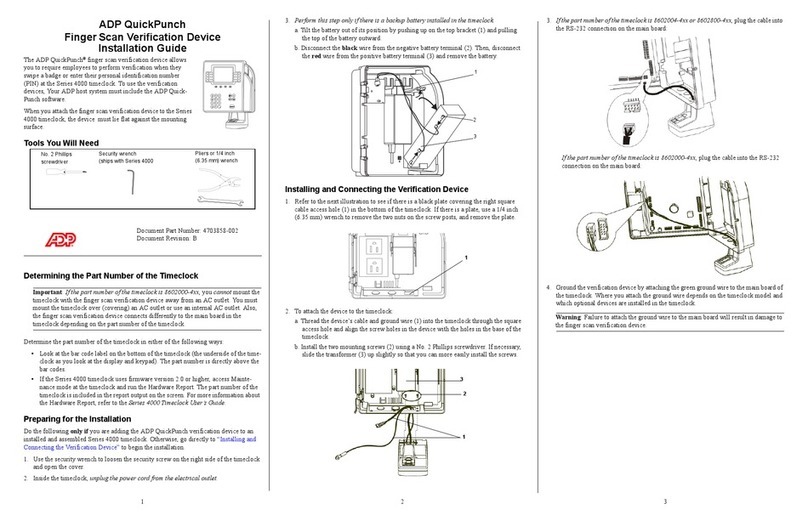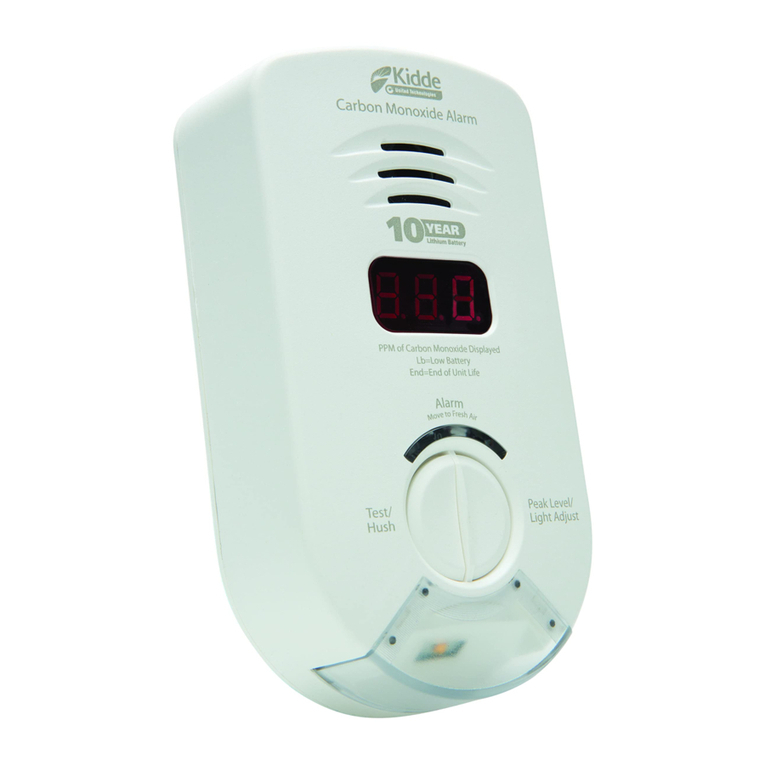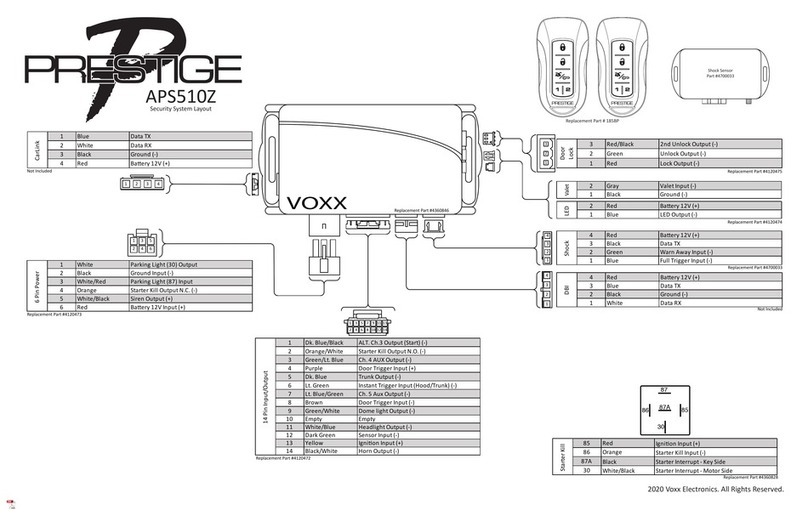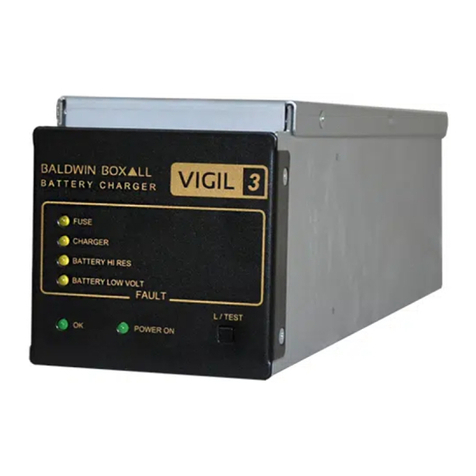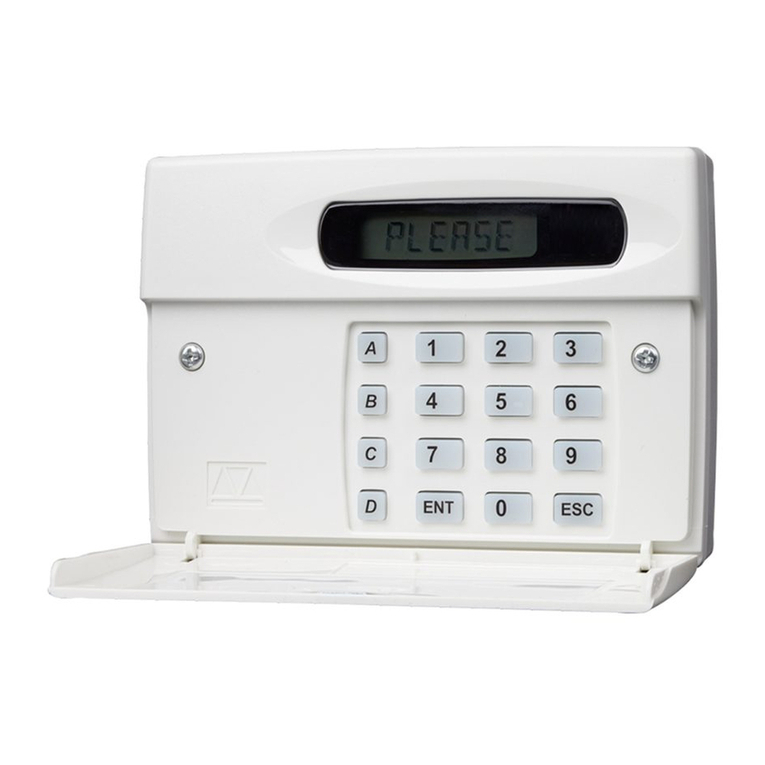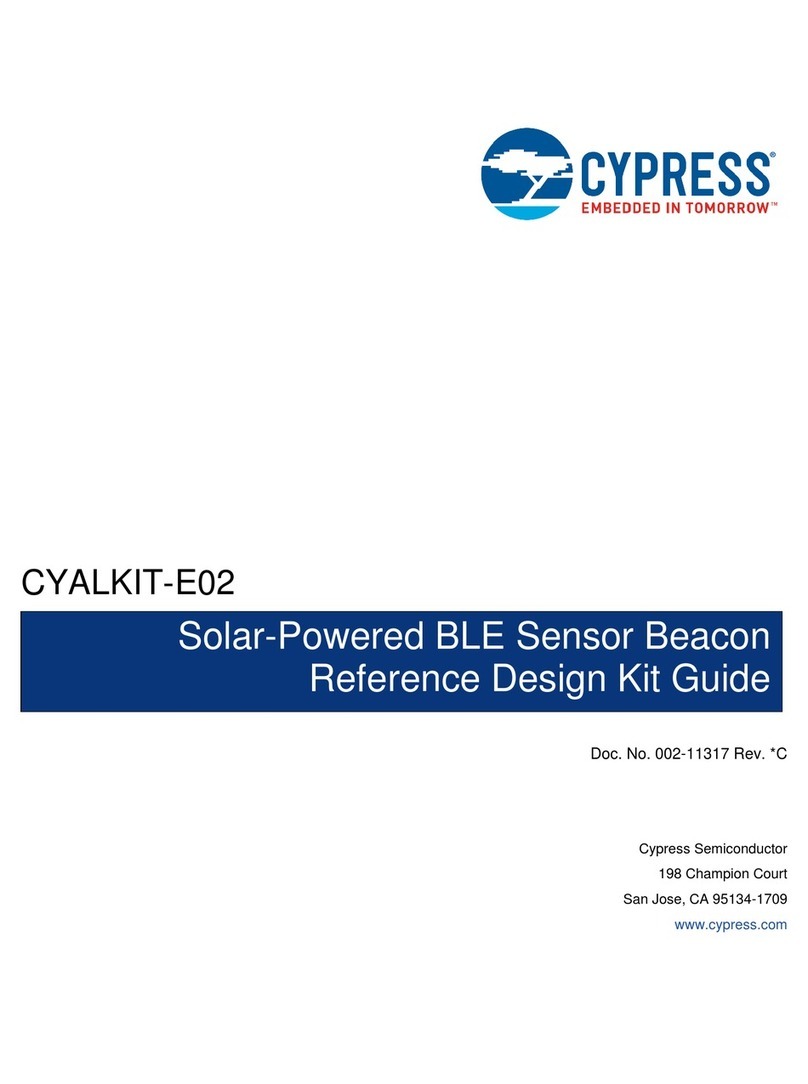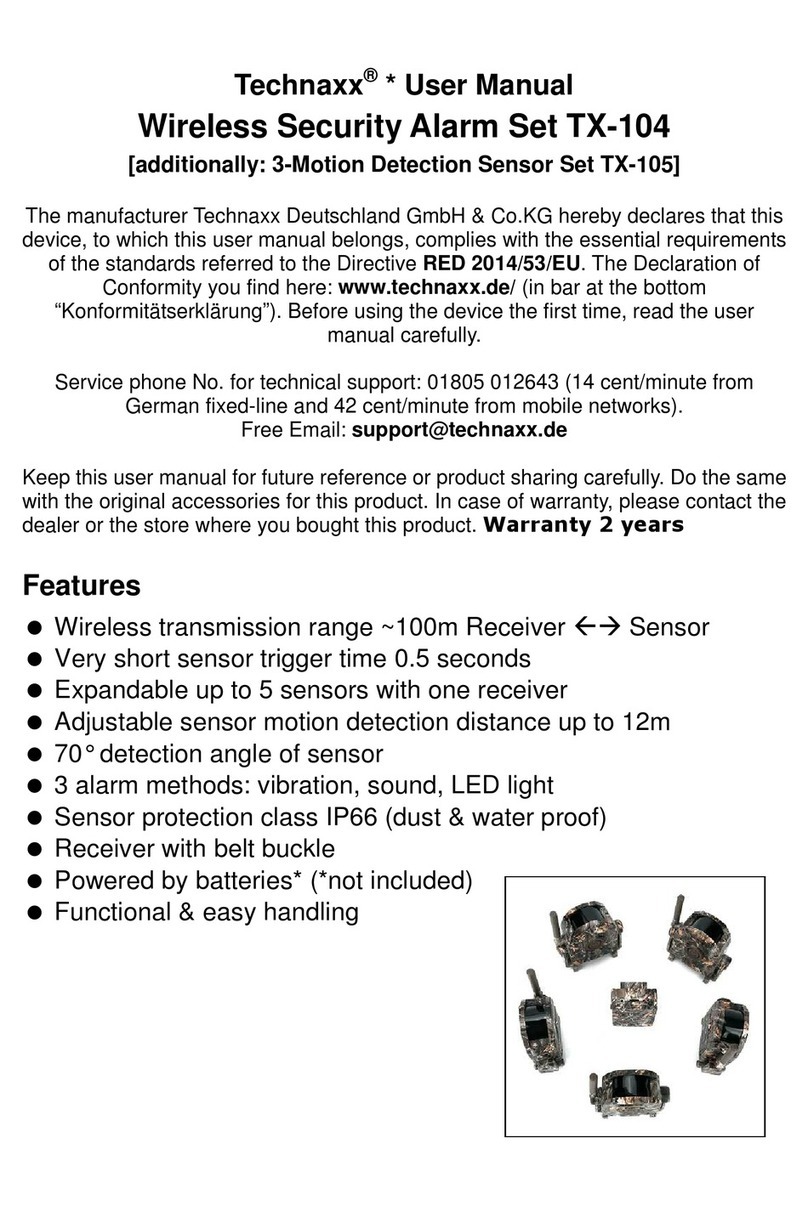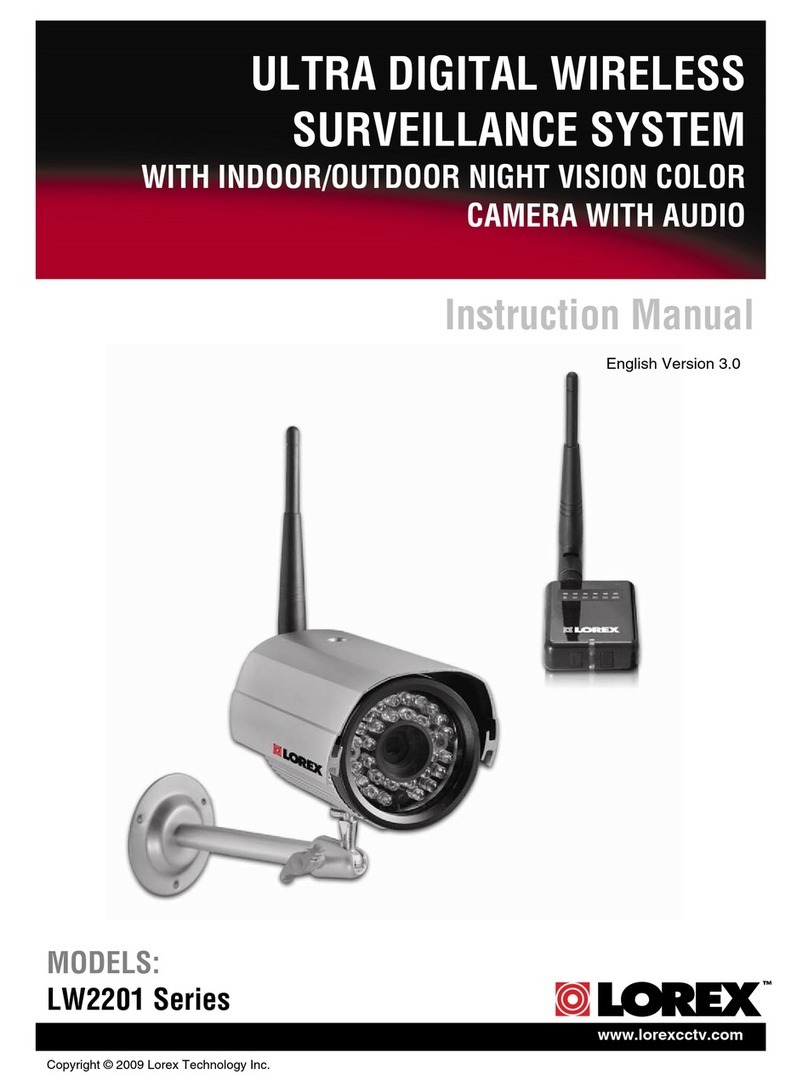Eldes ESIM264 User manual

ESIM264
GSM ALARM AND MANAGEMENT SYSTEM
INSTALLATION MANUAL
COMPLIES WITH EN 50131-1 GRADE 2, CLASS II REQUIREMENTS

2
2
EN MANUAL ELDES ESIM264 V3.1
Installation Manual v3.1
Valid for ESIM264 v7.15.00 and up
Safety instructions
Please read and follow these safety guidelines in order to maintain safety of operators and people around:
• GSM alarm & management system ESIM264 (also referenced as alarm system, system or device) has radio transceiver operating in GSM
850/900/1800/1900 bands.
• DO NOT use the system where it can be interfere with other devices and cause any potential danger.
• DO NOT use the system with medical devices.
• DO NOT use the system in hazardous environment.
• DO NOT expose the system to high humidity, chemical environment or mechanical impacts.
• DO NOT attempt to personally repair the system.
• System label is on the bottom side of the device.
GSM alarm system ESIM264 is a device mounted in limited access areas. Any system repairs must be done only by qualied,
safety aware personnel.
The system must be powered by main 16-24V 50 Hz ~1.5A max or 18-24V 1,5A max DC power supply which must be
approved by LST EN 60950-1 standard and be easily accessible nearby the device. When connecting the power supply to the
system, switching the pole terminals places does not have any aect.
Any additional devices linked to the system ESIM264 (computer, sensors, relays etc.) must be approved by LST EN 60950-1
standard.
Main power supply can be connected to AC mains only inside installation room
with automatic 2-pole circuit breaker capable of disconnecting circuit in the
event of short circuit or over-current condition. Open circuit breaker must have a
gap between connections of more than 3mm and the disconnection current 5A.
Phase
AC 230V
50 Hz/DC 24V
USB cable
Null
PE
ESIM264
AC/DC
Mains power and backup battery must be disconnected before any installation or tuning work starts. The system installation
or maintenance must not be done during stormy conditions
Backup battery must be connected via the connection which in the case of breaking would result in disconnection of one of
battery pole terminals. Special care must be taken when connecting positive and negative battery terminals. Switching the
pole terminals places is NOT allowed.
In order to avoid re or explosion hazards the system must be used only with approved backup battery.
The device is fully turned o by disconnecting 2-pole switch o device of the main power supply and disconnecting backup
battery connector.
Fuse F1 type – Slow Blown 3A. Replacement fuses have to be exactly the same as indicated by the manufacturer.
If you use I security class computer for setting the parameters it must be connected to earth.
The WEEE (Waste Electrical and Electronic Equipment) marking on this product (see left) or its documentation indicates that
the product must not be disposed of together with household waste. To prevent possible harm to human health and/or the
environment, the product must be disposed on in an approved and environmentally safe recycling process. For further infor-
mation on how to dispose of this product correctly, contact the system supplier, or the local authority responsible for waste
disposal in your area.

3
3
EN
MANUAL ELDES ESIM264 V3.1
Contents
1. GENERAL INFORMATION.........................................................................................................................................................6
1.1. Functionality......................................................................................................................................................................................................6
1.2. Compatible Device Overview...........................................................................................................................................................................6
1.3. Default Parameters & Ways of Parameter Conguration ...........................................................................................................................6
2. Technical Specications .......................................................................................................................................................12
2.1. Electrical & Mechanical Characteristics.......................................................................................................................................................12
2.2. Main Unit, LED & Connector Functionality..................................................................................................................................................13
2.3. Wiring Diagrams ..............................................................................................................................................................................................14
3. INSTALLATION ...................................................................................................................................................................... 20
4. GENERAL OPERATIONAL DESCRIPTION .............................................................................................................................. 24
5. CONFIGURATION METHODS ..................................................................................................................................................25
6. PASSWORDS.......................................................................................................................................................................... 28
7. SYSTEM LANGUAGE .............................................................................................................................................................. 29
8. USER PHONE NUMBERS ....................................................................................................................................................... 30
8.1. System Control from any Phone Number....................................................................................................................................................31
9. DATE AND TIME......................................................................................................................................................................33
10. USER PASSWORDS................................................................................................................................................................ 34
11. iBUTTON KEYS ...................................................................................................................................................................... 36
11.1. Adding and Removing iButton Keys............................................................................................................................................................ 36
12. ARMING AND DISARMING..................................................................................................................................................... 38
12.1. Free of Charge Phone Call............................................................................................................................................................................. 38
12.2. SMS Text Message.......................................................................................................................................................................................... 39
12.3. EKB2 Keypad and User Password................................................................................................................................................................ 40
12.4. EKB3 Keypad and User Password................................................................................................................................................................ 41
12.5. iButton Key...................................................................................................................................................................................................... 42
12.6. EWK1/EWK2 Wireless Keyfob ...................................................................................................................................................................... 42
12.7. Arm-Disarm by Zone ...................................................................................................................................................................................... 43
12.8. Disabling and Enabling Arm/Disarm Notications.................................................................................................................................... 44
13. EXIT AND ENTRY DELAY ....................................................................................................................................................... 46
14. ZONES.................................................................................................................................................................................... 48
14.1. Zone Numbering............................................................................................................................................................................................. 48
14.2. Zone Expansion .............................................................................................................................................................................................. 48
14.3. 6-Zone Mode................................................................................................................................................................................................... 48
14.4. ATZ (Advanced Technology Zone) Mode.................................................................................................................................................... 49
14.5. Zone Type Denitions ................................................................................................................................................................................... 50
14.6. Zone Attributes ...............................................................................................................................................................................................51
14.7. Bypassing and Activating Zones.................................................................................................................................................................. 54
14.8. Zone Names .................................................................................................................................................................................................... 54
14.9. Disabling and Enabling Zones .......................................................................................................................................................................55
15. STAY MODE.............................................................................................................................................................................56
16. TAMPERS................................................................................................................................................................................57
16.1. Tamper Names.................................................................................................................................................................................................57
17. ALARM INDICATIONS AND NOTIFICATIONS ......................................................................................................................... 58
17.1. Enabling and Disabling Alarm Notications............................................................................................................................................... 59
18. PROGRAMMABLE (PGM) OUTPUTS...................................................................................................................................... 62
18.1. PGM Output Numbering ................................................................................................................................................................................ 62
18.2. PGM Output Expansion.................................................................................................................................................................................. 62
18.3. PGM Output Names........................................................................................................................................................................................ 63
18.4. Turning PGM Outputs ON and OFF............................................................................................................................................................... 63
18.5. PGM Output Control by Event and Scheduler ............................................................................................................................................ 65
18.6. Wireless PGM Output Type Denitions....................................................................................................................................................... 66
19. WIRELESS DEVICES................................................................................................................................................................67
19.1. Binding, Removing and Replacing Wireless Devicess .............................................................................................................................. 67
19.2. Wireless Device Information and Signal Status Monitoring.................................................................................................................... 69
19.3. Disabling and Enabling Siren if Wireless Signal is Lost ............................................................................................................................ 70
20. SIREN/BELL............................................................................................................................................................................71
20.1. Bell Squawk......................................................................................................................................................................................................72
20.2. Indication by EWS2 Indicators.......................................................................................................................................................................72
20.3. EWF1 Interconnection....................................................................................................................................................................................73

4
4
EN MANUAL ELDES ESIM264 V3.1
21. BACKUP BATTERY, MAINS POWER SUPPLY STATUS MONITORING AND MEMORY..............................................................74
22. GSM CONNECTION STATUS MONITORING .............................................................................................................................77
23. PARTITIONS .......................................................................................................................................................................... 78
23.1. Zone Partition ................................................................................................................................................................................................. 78
23.2. User Phone Number Partition ...................................................................................................................................................................... 78
23.3. Keypad Partition and Keypad Partition Switch.......................................................................................................................................... 79
23.4. User Password Partition .............................................................................................................................................................................. 80
23.5. iButton Key Partition ..................................................................................................................................................................................... 80
23.6. EWK1/EWK2 Wireless Keyfob Partition...................................................................................................................................................... 80
24. TEMPERATURE SENSORS ......................................................................................................................................................81
24.1. Adding, Removing and Replacing Temperature Sensors ........................................................................................................................ 81
24.2. Setting Up MIN and MAX Temperature Boundaries. Temperature Info SMS ....................................................................................... 81
25. REMOTE LISTENING AND 2-WAY VOICE COMMUNICATION.................................................................................................. 83
26. SYSTEM INFORMATION. INFO SMS....................................................................................................................................... 84
26.1. Periodic Info SMS............................................................................................................................................................................................ 84
27. SYSTEM NOTIFICATIONS ...................................................................................................................................................... 86
27.1. SMSC (Short Message Service Center) Phone Number............................................................................................................................ 89
28. EVENT LOG ............................................................................................................................................................................ 90
29. INDICATION OF SYSTEM FAULTS ...........................................................................................................................................91
30. MONITORING STATION.......................................................................................................................................................... 93
30.1. Data Messages – Events................................................................................................................................................................................ 94
30.2. Communication............................................................................................................................................................................................... 98
31. ELDES WIRED DEVICES ....................................................................................................................................................... 108
31.1. RS485 Interface ...........................................................................................................................................................................................108
31.2. 1-Wire Interface.............................................................................................................................................................................................121
31.3. Modules Interface .........................................................................................................................................................................................121
32. ELDES WIRELESS DEVICES.................................................................................................................................................. 126
32.1. EWT1 - Wireless Transmitter-Receiver..................................................................................................................................................... 126
32.2. EW1 - Wireless Zone & PGM Output Expansion Module ........................................................................................................................ 127
32.3. EWP1 – Wireless Motion Detector ............................................................................................................................................................. 129
32.4. EWD1 – Wireless Magnetic Door Contact.................................................................................................................................................. 131
32.5. EWK1 - Wireless Keyfob .............................................................................................................................................................................. 133
32.6. EWS1 – Wireless Indoor Siren..................................................................................................................................................................... 135
32.7. EWS2 – Wireless Outdoor Siren.................................................................................................................................................................. 137
32.8. EW1B - Battery-Powered Wireless Zone & PGM Output Expansion Module...................................................................................... 140
32.9. EWF1 - Wireless Smoke Detector .............................................................................................................................................................. 143
32.10. EWK2 - Wireless Keyfob ............................................................................................................................................................................. 148
32.11. EWD2 - Wireless Door Contact/Shock Sensor/Water Sensor................................................................................................................151
32.12. EWS3 - Wireless Indoor Siren .................................................................................................................................................................... 155
33. REMOTE SYSTEM RESTART .................................................................................................................................................159
34. TECHNICAL SUPPORT ........................................................................................................................................................ 160
34.1. Troubleshooting ........................................................................................................................................................................................... 160
34.2. Restoring Default Parameters ................................................................................................................................................................... 160
34.3. Updating the Firmware via USB Cable Locally........................................................................................................................................ 160
34.4. Updating Firmware via GPRS Connection Remotely .............................................................................................................................. 161
34.5. Frequently Asked Questions...................................................................................................................................................................... 162
35. RELATED PRODUCTS........................................................................................................................................................... 164

5
5
EN
MANUAL ELDES ESIM264 V3.1
Limited Liability
The buyer must agree that the system will reduce the risk of re, theft, burglary or other dangers but does not guarantee against such
events.
“ELDES UAB” will not take any responsibility regarding personal or property or revenue loss while using the system.
“ELDES UAB” liability according to local laws does not exceed value of the purchased system. “ELDES UAB” is not aliated with any of the
cellular providers therefore is not responsible for the quality of cellular service.
Manufacturer Warranty
The system carries a 24-month warranty by the manufacturer “ELDES UAB”. Warranty period starts from the day the system has been
purchased by the end user. The warranty is valid only if the system has been used as intended, following all guidelines listed in the manual
and within specied operating conditions. Receipt must be kept as a proof of purchase date.
The warranty is voided if the system has been exposed to mechanical impact, chemicals, high humidity, uids, corrosive and hazardous
environments or other force majeure factors.
Package Content
1. ESIM264............... ..................................... qty. 1
2. Microphone................................................qty.1
3. SMA antenna......... ................................... qty. 1
4. Buzzer........................... ............................. qty. 1
5. Back-up battery connection wire... ...... qty. 1
6. User manual.............................................. qty. 1
7. Resistors 5,6k......................... ...............qty. 6
8. Resistors 3,3k........................................qty. 6
9. Plastic standos................ ......................qty. 4
About Installation Manual
This document describes detailed installation and operation process of alarm system ESIM264. It is very important to read the installation
manual before starting to use the system.
Copyright © “ELDES UAB”, 2013. All rights reserved
It is not allowed to copy and distribute information in this document or pass to a third party without advanced written authorization
by “ELDES UAB”. “ELDES UAB” reserves the right to update or modify this document and/or related products without a warning.
Hereby, “ELDES UAB” declares that this GSM alarm and management system ESIM264 is in compliance with the essential require-
ments and other relevant provisions of Directive 1999/5/EC. The declaration of conformity may be consulted at www.eldes.lt

6
6
EN MANUAL ELDES ESIM264 V3.1
1. GENERAL INFORMATION
1.1. Functionality
ESIM264 – micro-controller based alarm system for houses, cottages, country homes, garages and other buildings, also capable of manag-
ing electrical appliances via cellular GSM/GPRS network. It can also be used as Intercom system.
Examples of using the system:
• Property security.
• Alarm switch.
• Thermostat, heating and air-conditioner control, temperature monitoring.
• Lighting, garden watering, water pump and other electrical equipment control via SMS text messages.
• Remote listening to what is happening in the secured area.
• Main 230V power status with SMS text message.
• Two-way intercom device via GSM network.
1.2. Compatible Device Overview
Wired Devices
Device Description Max. Connectable Devices
EKB2 LCD keypad 4*
EKB3 LED keypad 4*
EA1 Audio output module with 3,5mm jack 1**
EA2 Audio amplier module 1W 8 1**
EPGM1 16 zone and 2 PGM output expansion module 1
EPGM8 8 PGM output expansion module 1**
Wireless Devices
Device Description Max. Connectable Devices
EW1 Wireless 2 zone and 2 PGM output expansion module 16***
EW1B Battery-powered wireless 2 zone and 2 PGM output expansion module 16***
EWP1 Wireless motion detector 16***
EWD1 Wireless magnetic door contact 16***
EWD2 Wireless magnetic door contact/shock sensor/water sensor 16***
EWK1**** Wireless keyfob with 4 buttons 5***
EWK2**** Wireless keyfob with 4 buttons 5***
EWS1 Wireless indoor siren 16***
EWS2 Wireless outdoor siren 16***
EWS3 Wireless indoor siren 16***
EWF1 Wireless smoke detector 16***
* - A mixed combination of EKB2 and EKB3 keypads is supported. The combination can consist of up to 4 keypads in total.
** - Only 1 of these modules can be connected at a time if the module slots are implemented in ESIM264 unit.
*** - A mixed combination of wireless devices is supported. The combination can consist of up to 32 wireless devices in total.
**** - A mixed combination of EWK1 and EWK2 keyfobs is supported. The combination can consist of up to 5 keyfobs in total.
1.3. Default Parameters & Ways of Parameter Conguration
Main Settings
Parameter Default Value
Congurable by:
SMS EKB2 EKB3 Conguration
Tool
SMS & EKB2 Menu Language Depends on rmware version according to user‘s lo-
cation
SMS Password 0000
User Password 1 1111
User Password 2... 30 N/A
Administrator Password 1470
Duress Password N/A
SGS Password N/A
User 1... 5 Phone Number N/A
Allow Control from Any Phone Number Disabled
Date & Time N/A
Exit Delay - Partition 1... 4 15 seconds
Info SMS Scheduler Frequency (days) – 1; Time - 11

7
7
EN
MANUAL ELDES ESIM264 V3.1
Zones
Parameter Default Value
Congurable by:
SMS EKB2 EKB3 Conguration
Tool
Zone Name Z1 - Zone 1; Z2 - Zone 2; Z3 - Zone 3; Z4 - Zone 4; Z5 -
Zone 5; Z6 - Zone 6
Entry Delay 15 seconds
On-Board Zone Delay 800 milliseconds
EPGM1 Zone Delay 800 milliseconds
On-board Z1 Zone Type Delay
On-board Z2... Z12 Zone Type Instant
Keypad Zone Type Instant
EPGM1 Zone Type Instant
Wireless Zone Type Depends on the connected wireless device
Virtual Zone Type Interior Follower
ATZ Mode Disabled
6-Zone Mode: Zone Connection Type Type 1
ATZ Mode: Zone Connection Type Type 4
On-board Zone Status Enabled
Keypad Zone Status Disabled
EPGM1 Zone Status Enabled
Wireless Zone Status Depends on the connected wireless device
Virtual Zone Status Disabled
Stay attribute for individual zone Disabled
Arm-Disarm by Zone N/A
Force atrribute for individual zone Disabled
Tamper Name Tamper 1, Tamper 2, Tamper 3, Tamper 4, Tamper 5,
Tamper 6 etc.
Chime Enabled
PGM Outputs
Parameter Default Value
Congurable by:
SMS EKB2 EKB3 Conguration
Tool
PGM Output Name C1 – Controll1, C2 – Controll2, C3 – Controll3, C4 – Con-
troll4 etc.
PGM Output Status Disabled
EPGM8 PGM Output Status Disabled
EPGM1 PGM Output Status Disabled
Wireless PGM Output Status Enabled
Wireless PGM Output Type Depends on the connected wireless device
PGM Output Control by Event 1... 16 Disabled
PGM Output Control by Event Manage-
ment
Scheduler 1... 16 Disabled
Turn ON/OFF PGM Output by Timer
Using Module EPGM8 Mode Disabled
Alarm Duration & Siren
Parameter Default Value
Congurable by:
SMS EKB2 EKB3 Conguration
Tool
Alarm Duration 1 minute
EWS2 LED Disabled
Bell Squawk Disabled
Activate Siren if Wireless Device is Lost Disabled

8
8
EN MANUAL ELDES ESIM264 V3.1
Alarm Notications & Arm/Disarm Notications
Parameter Default Value
Congurable by:
SMS EKB2 EKB3 Conguration
Tool
Call in Case of Alarm Enabled
Send Alarm SMS to All Users Simulta-
neously Disabled
Send Arm/Disarm SMS to User 1... 5 Enabled
Send Arm/Disarm SMS to All Selected
Users Simultaneously Disabled
Main Power Status
Parameter Default Value
Congurable by:
SMS EKB2 EKB3 Conguration
Tool
Main Power Loss Delay 30 seconds
Main Power Restore Delay 120 seconds
Peripheral Devices
Parameter Default Value
Congurable by:
SMS EKB2 EKB3 Conguration
Tool
Temperature Sensor MIN 0 °C
Temperature Sensor MAX 0 °C
Allow adding New iButton Keys Disabled
System Notications
Parameter Parameter
Congurable by:
SMS EKB2 EKB3 Conguration
Tool
General Alarm Enabled
System Disarmed Enabled
System Armed Enabled
Main Power Loss Event Enabled Enabled
Main Power Restore Event Enabled Enabled
Low Battery Enabled
Periodical Info Enabled
Tamper Alarm Event Enabled
Battery Failed Enabled
System Started Enabled
Wireless Signal Loss Enabled
Temperature Fallen Enabled
Temperature Exceeded Enabled
System Shutdown Enabled
Partitions
Parameter Default Value
Congurable by:
SMS EKB2 EKB3 Conguration
Tool
Partition 0 Name PART0
Partition 1 Name PART1

9
9
EN
MANUAL ELDES ESIM264 V3.1
Partitions
Parameter Default Value
Congurable by:
SMS EKB2 EKB3 Conguration
Tool
Keypad 1... 4 Partition PART0
Keypad Partition Switch Disabled
User Password 1... 30 Partition PART0
User 1... 5 Phone Number Partition PART0
iButton 1... 5 Partition PART0
Zone Partition PART0
Monitoring Station
Parameter Default Value
Congurable by:
SMS EKB2 EKB3 Conguration
Tool
MS Mode Disabled
Data Messages All Enabled
Account (Alarm System ID) 9999
Monitoring Station Phone Number 1... 3
(Voice Calls/SMS) N/A
Attempts (Voice Calls/SMS) 3
Monitoring Station Phone Number 1...
5 (CSD) N/A
Attempts (CSD) 3
Server IP Address (GPRS) 0.0.0.0
DNS1 Server IP Address (GPRS) N/A
DNS2 Server IP Address (GPRS) N/A
Protocol (GPRS) UDP
Server Port (GPRS) 20000
Local Port (GPRS) N/A
APN (GPRS) N/A
User (GPRS) N/A
Password (GPRS) N/A
Prole (GPRS) Prole1
GPRS Attempts 3
Delay Between Attempts (GPRS) 600 seconds
Unit ID (GPRS) 0000
Test Period (GPRS) 180 seconds
Communication - Primary N/A
Communication - Backup 1... 4 N/A
Protocol over GPRS EGR100

10
10
EN MANUAL ELDES ESIM264 V3.1
Additional Parameters
Parameter Default Value
Congurable by:
SMS EKB2 EKB3 Conguration
Tool
Event Log Enabled
Microphone Gain 12
Speaker Level 85
GSM Signal Loss Indication - Delay 180 seconds
GSM Signal Loss Indication - Activate
Output N/A
Show ARMED Status in Keypad (EKB2) Disabled
ELDES Smart Security
Parameter Default Value
Congurable by:
SMS EKB2 EKB3 Conguration
Tool
ELDES Smart Security Disabled
Server Address ss.eldes.lt
Port 8082
Ping Period 180 seconds
Time Zone 0

11
11
EN
MANUAL ELDES ESIM264 V3.1

12
12
EN MANUAL ELDES ESIM264 V3.1
2.TECHNICAL SPECIFICATIONS
2.1. Electrical & Mechanical Characteristics
Electrical & Mechanical Characteristics
Main power supply 16-24V 50 Hz ~1.5A max / 18-24V 1,5A max
Current in standby without external sensors and keypad Up to 80mA
Recommended backup battery voltage, capacity 12V; 1,3-7 Ah
Recommended backup battery type Lead-Acid
Maximum battery charge current 900mA
Gsm modem frequency 850/900/1800/1900MHz
Cable type for GSM/GPRS antenna connection Shielded
Number of zones on-board 6 (ATZ mode: 12)
Nominal zone resistance 5,6k (ATZ Mode: 5,6k and 3,3k)
Number of PGM outputs on-board 4
On-board PGM output circuit
Maximum commuting on-board PGM output values 4 x Voltage – 30V; current – 500mA.
BELL: Siren output when activated Connected to COM
BELL: Maximum cable length for siren connection Up to 100 meters
BELL: Cable type for siren connection Unshielded
AUX: Auxiliary equipment power supply voltage 13,8V DC
BELL+AUX: Maximum accumulative current of auxiliary equipment & siren 1 A
AUX: Maximum cable length for auxiliary equipment connection Up to 100 meters
AUX: Cable type for auxiliary equipment connection Unshielded
BUZ: Maximum current of mini buzzer 150mA
BUZ: Power supply voltage of buzzer 5V DC
BUZ: Cable type for mini buzzer connection Unshielded
Supported temperature sensor model Maxim®/Dallas® DS18S20, DS18B20
Maximum supported number of temperature sensors 1
DATA: Maximum cable length for 1-Wire communication Up to 30 meters
DATA: Cable type for 1-Wire communication Unshielded
Supported ibutton key model Maxim®/Dallas® DS1990A
Maximum supported number of iButton keys 5
Maximum supported number of keypads 4 x EKB2 / EKB3
Y/G: Maximum cable length for RS485 communication Up to 100 meters
Y/G: Cable type for RS485 communication Unshielded
MIC: Maximum cable length for microphone connection Up to 2 meters
MIC: Cable type for microphone connection Unshielded
Wireless transmitter-receiver frequency 868 Mhz
Wireless communication range Up to 30m in premises; up to 150m in open areas
Maximum supported number of wireless devices 16
Event log size 500 events
Maximum supported number of zones 44
Maximum supported number of pgm outputs 44
Cable type for zone and pgm output connection Unshielded
Communications SMS, Voice calls, GPRS network, RS485, CSD
Supported protocols Ademco Contact ID, EGR100, Kronos, Cortex SMS
Dimensions 140x100x18mm
Operating temperature range -20...+55 °C
Humidity 0-90% RH @ 0... +40 °C (non-condensing)
1 R OUT Open Collector Output.
Output is pulled to COM
when turned ON.

13
13
EN
MANUAL ELDES ESIM264 V3.1
2.2. Main Unit, LED & Connector Functionality
Main Unit Functionality
GSM MODEM GSM network 850/900/1800/1900MHz
modem
SIM CARD SIM card slot / holder
DEF Pins for restoring default settings
USB Mini USB port
FUSE F1 3A fuse
ANTENNA GSM/GPRS antenna SMA type connector
MODULES* Slots for EA1, EA2 or EPGM8 module
EWT1 Slots for EWT1 wireless module
C4
C3
SMA
ANTENNA
FU SE
3A
PWR
Z4
Z3
Z2
Z1
C1
C2
NETWORK
Z5
Z6
STA TUS
EWT1
MODULES
SIM CARD
DEF
PRG
USB
OPEN
C O M
BELL-
BELL+
G
Y
C2
AUX-
AUX+
AC /DC
AC /DC
Z1
C O M
Z2
Z3
C O M
Z4
DAT A
+5V
M IC -
MIC +
BU Z -
C1
BU Z +
C O M
C O M
Z6
Z5
G S M
MO DE M
AKU +
AKU -
1
LED Functionality
NETWORK GSM network signal strength
C2, C1 PGM output C1, C2 status – on/o
Z1 Zone Z1 state – alarm/restore (ATZ mode: Z1 and Z7)
Z2 Zone Z2 state – alarm/restore (ATZ mode: Z2 and Z8)
Z3 Zone Z3 state – alarm/restore (ATZ mode: Z3 and Z9)
Z4 Zone Z4 state – alarm/restore (ATZ mode: Z4 and Z10)
Z5 Zone Z5 state – alarm/restore (ATZ mode: Z5 and Z11)
Z6 Zone Z6 state – alarm/restore (ATZ mode: Z6 and Z12)
PWR Power supply status
STATUS Micro-controller status
Connector Functionality
Z1 - Z6 Security zones
COM Common terminal for all zones
DATA 1-Wire® interface for iButton® key & temperature sensor connection
+5V Temperature sensor power supply contact (+5V)
MIC- Microphone negative terminal
MIC+ Microphone positive terminal
BUZ- Mini buzzer negative terminal
BUZ+ Mini buzzer positive terminal
C1 - C4 PGM outputs
YRS485 interface CLOCK terminal (yellow wire)
GRS485 interface DATA terminal (green wire)
COM Common return terminal
BELL- Siren negative terminal
BELL+ Siren positive terminal
AUX- Negative power supply terminal for auxiliary equipment
AUX+ Positive power supply terminal for auxiliary equipment
AC/DC Main power supply terminal
AKU- Backup battery negative terminal
AKU+ Backup battery positive terminal
NETW indication GSM signal strength
OFF No GSM signal
Flashing every 3 sec. Poor
Flashing every 1 sec. Medium
Flashing several times per sec. Good
Steady ON Excellent

14
14
EN MANUAL ELDES ESIM264 V3.1
2.3. Wiring Diagrams
2.3.1.General Wiring
C O M
BELL-
BELL+
G
Y
C2
AUX-
AUX+
AC /DC
AC /DC
Z1
C O M
Z2
Z3
C O M
Z4
DATA
+5V
MIC -
MIC +
BUZ-
C1
BUZ+
C O M
C O M
Z6
Z5
MIC
BUZ
SIREN/BELL
iButton®
key reader
Temperature sensor EKB2EKB3
EPGM1
Z1
Z2
Backup Battery
12V 1.3-7Ah
Metal cabinet
PE terminal
Relay
module
500mA max.
Z4
Z3
Z5
Z6
Fuse 500 mA
~230V 50Hz
~16-24V
AKU+
AKU-
5,6 kΩ
5,6 kΩ
5,6 kΩ
5,6 kΩ
5,6 kΩ
5,6 kΩ
2
2.3.2. Zone Connection Types
Type 1 Example of 4-wire smoke detector wiring
Z1
COM
AUX+
+Vin
GND
C1
COM
NO
5,6 kΩ
3
6-Zone mode: Nor-
mally open contact
with 5,6K end-of-
line resistor.
Type 2 Example of magnetic door contact wiring
6-Zone mode: Nor-
mally closed contact
with 5,6K end-of-
line resistor COM
NC
Magnet
COM
Z1
5,6 kΩ
4
NOTE: Based on the example given, in the event of an alarm, the smoke detector could be reset by turining OFF and ON the PGM
output C1. For more details, please refer to 18.4. Turning PGM Outputs ON and OFF.
NOTE: The system does NOT support 2-wire smoke detectors.

15
15
EN
MANUAL ELDES ESIM264 V3.1
Type 3 Example of motion detector wiring
Z1
COM
COM
AUX+
AUX-
+Vin
GND
NC
TAMP
5,6 kΩ 3,3 kΩ
5
6-Zone mode: Tamper
and 5,6K end-of-line
resistor and 3,3K
end-of-line resistor
with normally closed
contact.
Type 4 Example of magnetic door contact (Z1) and glass break sensor (Z7) wiring
AUX+
+Vin
AUX-
GND
COM
COM
NC
NC
COM
Z1
5,6 kΩ
3,3 kΩ
Magnet
6
ATZ mode: 5,6K
end-of-line resistor
and normally closed
contact with 3,3K
end-of-line resistor
and normally closed
contact
Type 5 Example of motion detector (Z1) and magnetic door contact (Z7) wiring
Z1
COM
COM
COM
AUX+
AUX-
+Vin
GND
NC
NC
TAMP
5,6 kΩ5,6 kΩ 3,3 kΩ
Magnet
ATZ mode: Tamper,
5,6K end-of-line
resistor, 5,6K
end-of-line resistor
with normally closed
contact and 3,3K
end-of-line resistor
with normally closed
contact.
7
See also 14.3. 6-Zone Mode and 14.4. ATZ (Advanced Technology Zone) Mode.

16
16
EN MANUAL ELDES ESIM264 V3.1
2.3.3. Siren
RED +
BLACK -
BELL-
BELL+
SIREN/BELL
1A max.
8Piezo siren
1 Connect positive siren wire (red) to BELL+ ter-
minal.
2 Connect negative siren wire (black) to BELL-
terminal.
+12V
GND
BELL
BELL-
COM
BELL+
SIREN/BELL
1A max.
9Self-contained siren
1 Connect negative GND siren wire to COM termi-
nal.
2 Controlling BELL siren wire must be connected
to BELL- terminal.
3 Connect positive +12V siren wire to BELL+ ter-
minal.
See also 20. SIREN/BELL.
NOTE: BELL- is the commuted terminal intended for siren control.

17
17
EN
MANUAL ELDES ESIM264 V3.1
2.3.4. iButton Key Reader and Buzzer
BUZ-
BUZ+
+-
DATA
COM
BUZZER
iButton
key reader
DS1990A
10 Supported iButton key model: Maxim/Dallas
DS1990A
The iButton key reader can be installed with buzzer
or separately. The buzzer is intended for audio in-
dication of exit/entry delay countdown providing
short beeps.
1 Connect iButton key reader terminal wires to
1-Wire interface: COM and DATA terminals res-
pectively.
2 Connect buzzer‘s negative terminal wire to BUZ-
and positive terminal wire to BUZ+.
3 Additionally, a LED indicator for visual indication
can be installed in parallel to buzzer or instead.
Connect LED anode terminal to BUZ- and catho-
de to BUZ+.
NOTE: The installation of buzzer is not necessary if EKB2/EKB3 keypad is used.
ATENTION: The cable length for connection to 1-Wire interface can be up to 30 meters max.
2.3.5. Temperature Sensor and iButton Key Reader
Supported iButton key model: Maxim/Dallas DS1990A
Supported temperature sensor model: Maxim/Dallas DS18S20, DS18B20
COM
DATA
+5V
COM
DATA
+5V
GND +5V
DATA
TEMPERATURE SENSOR
DS18S20, DS18B20
GND
DATA +5V
iButton
key reader
DS1990A
TEMPERATURE
SENSOR
DS18S20,
DS18B20
GND DATA +5V
11 1 Connect temperature sensor GND, DATA, +5V
terminals to 1-Wire interface: COM, DATA and
+5V terminals respectively.
2 When connecting iButton key reader in parallel
to temperature sensor, connect iButton key rea-
der terminal wires to COM and DATA terminals
respectively.
ATENTION: The cable length for connection to
1-Wire interface can be up to 30 meters max.
2.3.6. Relay Finder 40.61.9.12 with Terminal Socket 95.85.3 to PGM Output
LED
A1
C1
AUX+
A2
COIL
RELAY
12
1 Wire up relay A1 terminal to PGM output Cx and
A2 terminal to AUX+.
2 In addition, connect LED indicator‘s anode ter-
minal to relay A2 terminal and cathode to A1
terminal.

18
18
EN MANUAL ELDES ESIM264 V3.1
2.3.7. RS485
Serial Wiring Method
ESIM264
a
b c d
e
EKB2/EKB3 EKB2/EKB3 EKB2/EKB3 EKB2/EKB3
EPGM1
Max. cable length: a+b+c+d+e = up to 100 meters
NOTE: If necessary, the RS485 devices can be powered from an external 12-14V DC power supply instead of AUX+ and AUX- terminals
ATTENTION: The cable length must not exceed 100 meters in total.
ATTENTION: When wiring more than 1 keypad, please ensure that the set address of each keypad is dierent.
NOTE: You may connect only 1 EKB2/EKB3 keypad or a mixed combination of EKB2 and EKB3 keypads. The combination can consist of
up to 4 keypads in total.
For more details on RS485 device installation, please refer to 32.1. RS485 Interface

19
19
EN
MANUAL ELDES ESIM264 V3.1
Parallel Wiring Method
ESIM264
EPGM1 EKB2/EKB3 EKB2/EKB3 EKB2/EKB3 EKB2/EKB3
Max. cable length: up to 100 meters
NOTE: If necessary, the RS485 devices can be powered from an external 12-14V DC power supply instead of AUX+ and AUX- terminals
ATTENTION: The cable between ESIM264 and each RS485 device must be of the same length and can NOT exceed 100 meters.
ATTENTION: When wiring more than 1 keypad, please ensure that the set address of each keypad is dierent.
NOTE: You may connect only 1 EKB2/EKB3 keypad or a mixed combination of EKB2 and EKB3 keypads. The combination can consist of
up to 4 keypads in total.
For more details on RS485 device installation, please refer to 32.1. RS485 Interface

20
20
EN MANUAL ELDES ESIM264 V3.1
3.INSTALLATION
• The system can be installed in a metal or non-ammable cabinet only. For a convenient installation, ME1 metal cabinet is highly recom-
mended. When using a dierent metal cabinet, it is necessary to ground it.
• For the connection of 230V transformer, use 3x0.75 mm21 thread double isolated cable. 230V power supply cables must not be
grouped with low voltage cable group.
• For the connection of auxiliary and BELL outputs, use 2x0.75 mm21 thread unshielded cable of up to 100 meters length.
• For the connection of zone/PGM output connectors, use 0.50 mm21 thread unshielded cable of up to 100 meters length.
System Installation in ME1 Metal Cabinet
1. ME1 metal cabinet components
Tamper switch
to AC main power line
to AC/DC terminals
of ESIM264 system
Phase
PE
Null blue
brown
Fuse 1A
Transformer
(Primary voltage: 230V AC,
Secondary voltage: 17V 2,35A)
13
2. Insert the plastic standos into the appropriate mounting points and x the board of ESIM264 on the holders as indicated below.
mounting points
14
Other manuals for ESIM264
6
Table of contents
Other Eldes Security System manuals

Eldes
Eldes ESIM264 User manual

Eldes
Eldes ESIM264 User manual
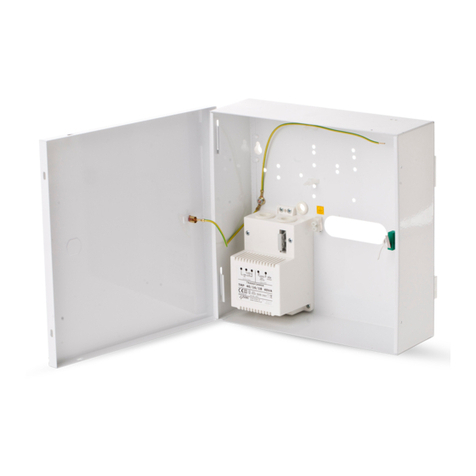
Eldes
Eldes ME1 User manual

Eldes
Eldes ESIM364 User manual

Eldes
Eldes ESIM264 User manual
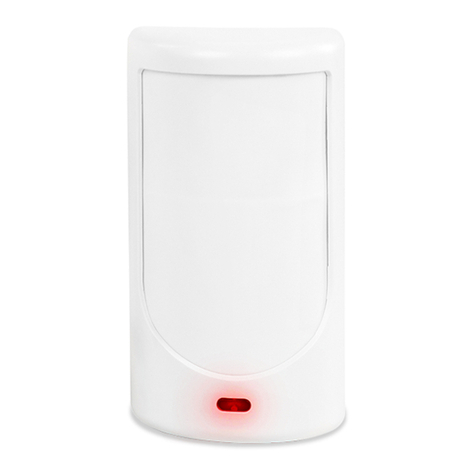
Eldes
Eldes PITBULL ALARM PRO User manual
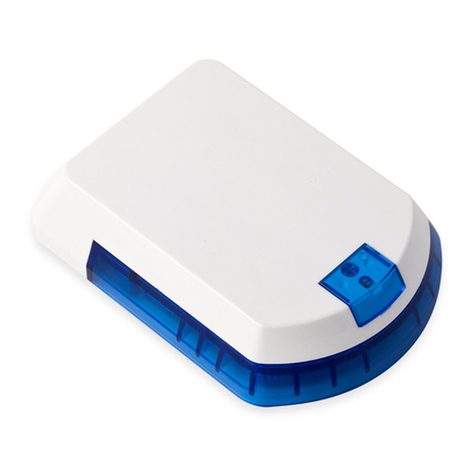
Eldes
Eldes EWS2 User manual

Eldes
Eldes EWS4 User manual

Eldes
Eldes EPIR2 Instruction sheet

Eldes
Eldes ESIM264 User manual
Popular Security System manuals by other brands
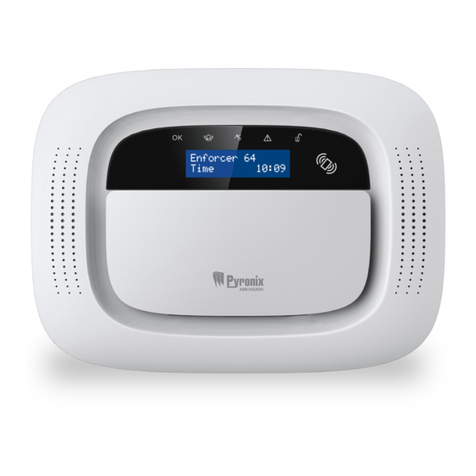
Pyronix
Pyronix Enforcer 64 installation guide
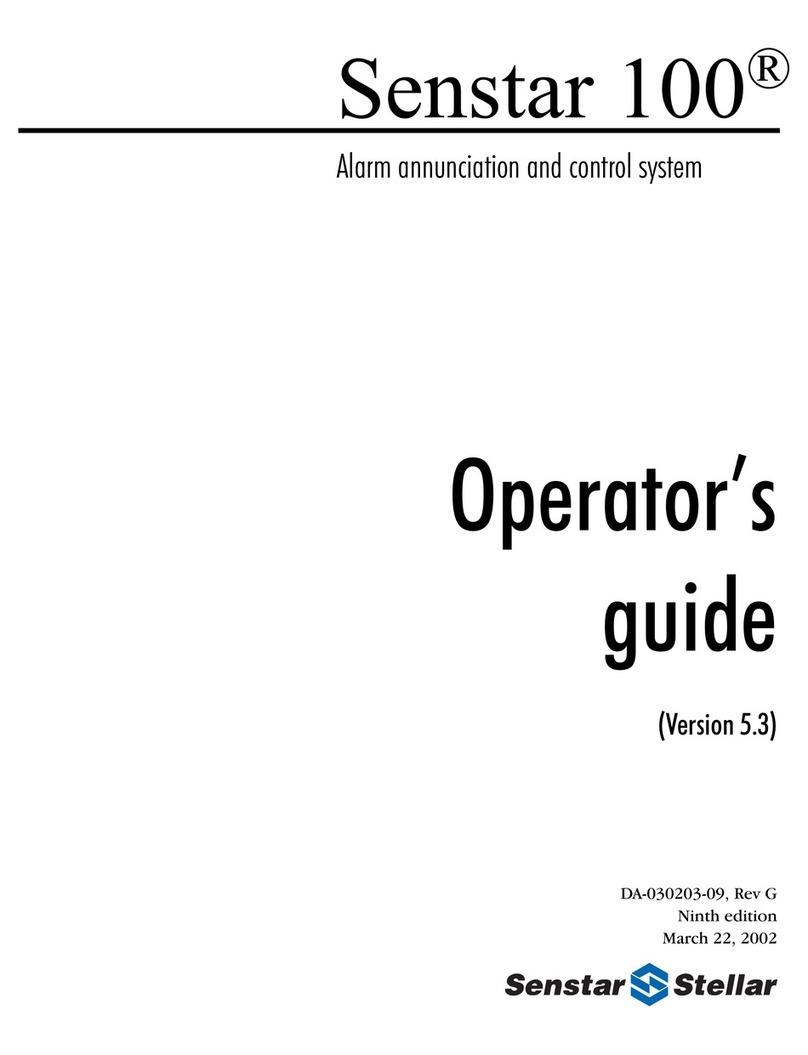
Senstar Stellar
Senstar Stellar 100 Operator's guide
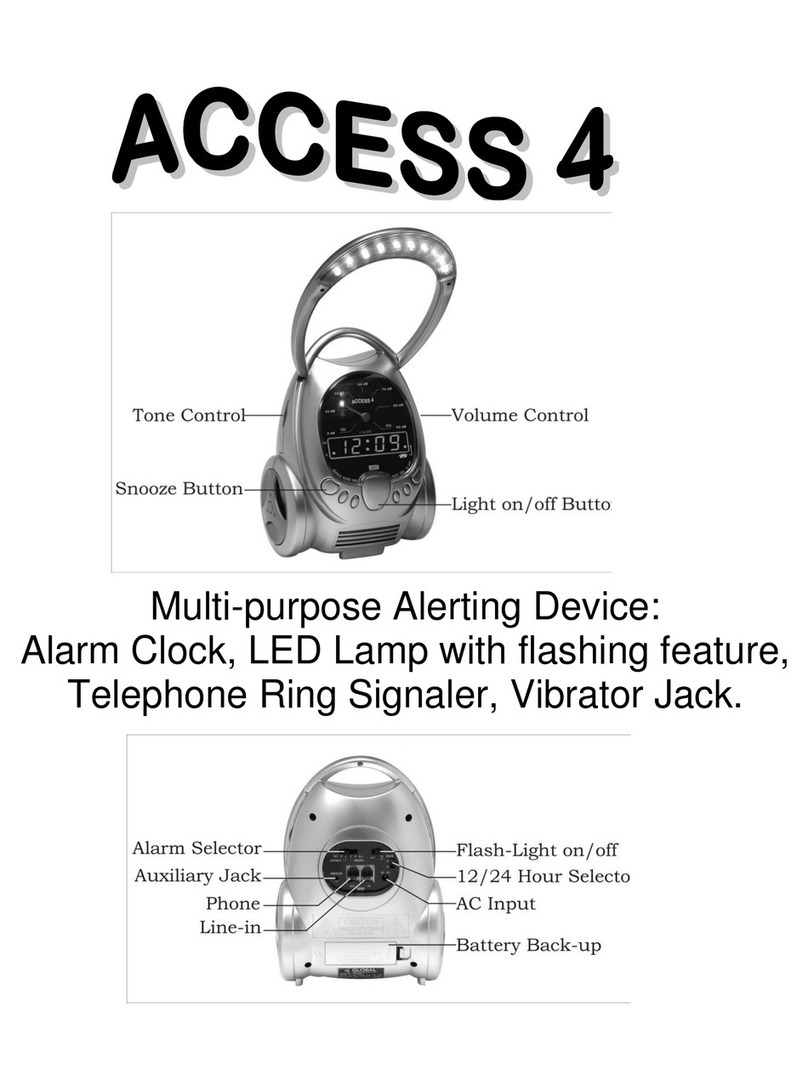
GLOBAL ASSISTIVE DEVICES
GLOBAL ASSISTIVE DEVICES Access 4 instruction manual
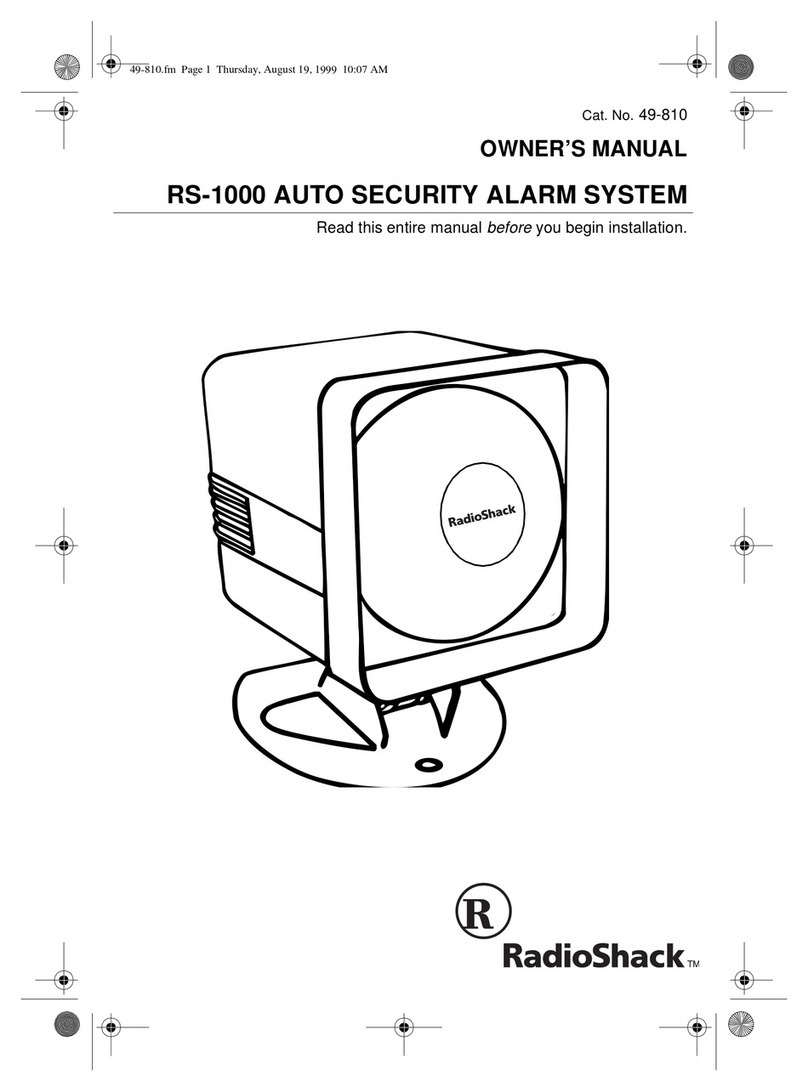
Radio Shack
Radio Shack RS-1000 owner's manual
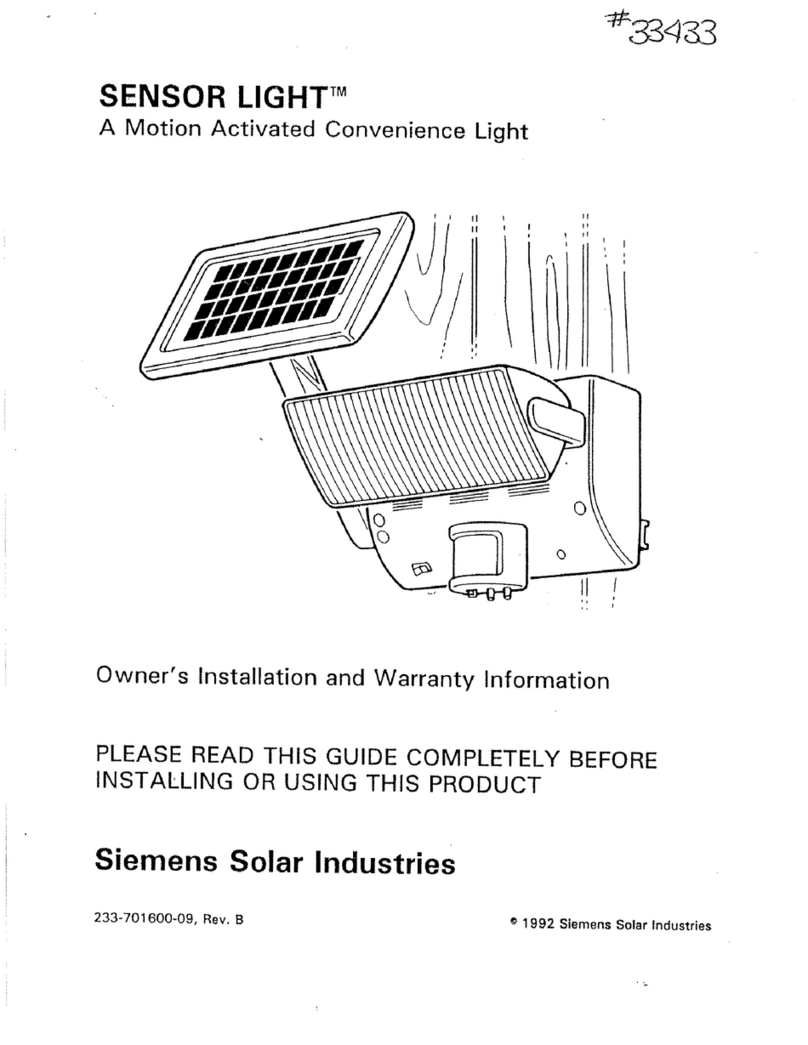
Siemens
Siemens Sensor Light owner's manual
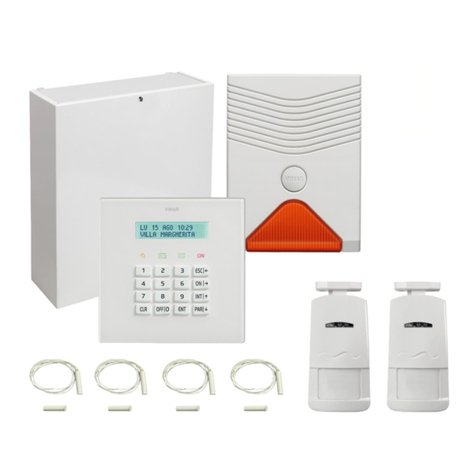
Vimar
Vimar By-alarm 01703.DE quick start guide



